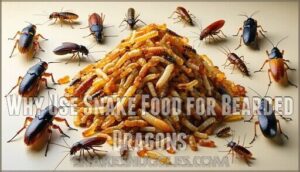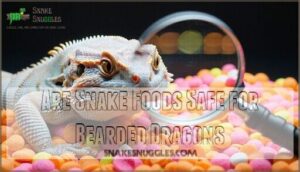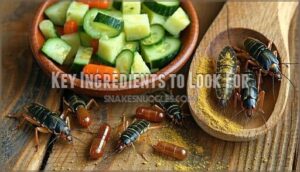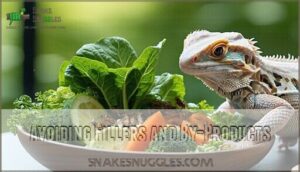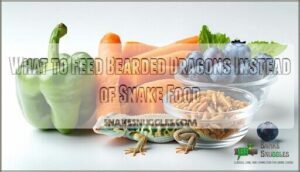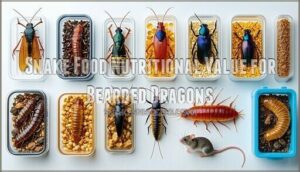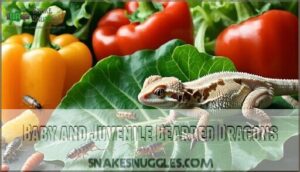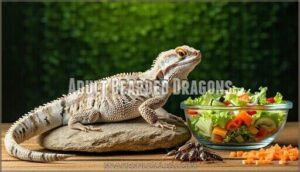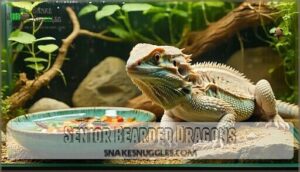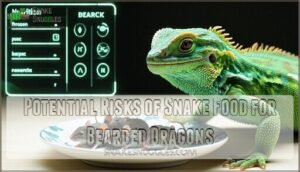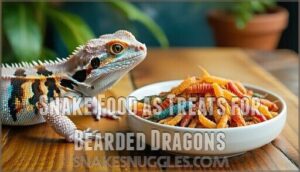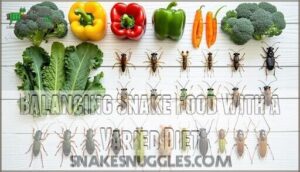This site is supported by our readers. We may earn a commission, at no cost to you, if you purchase through links.
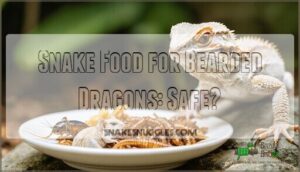
Don’t worry, you’re on the right track, snake food, like crickets and mealworms, can be a nutritious addition to your bearded dragon’s diet.
Just remember to choose foods that are low in fat and high in protein, and avoid foods that can cause allergic reactions.
With a little research, you can create a balanced diet that includes snake food for bearded dragons, and that’s just the beginning of keeping your pet happy and healthy.
Table Of Contents
- Key Takeaways
- Why Use Snake Food for Bearded Dragons
- Are Snake Foods Safe for Bearded Dragons
- Choosing The Best Snake Food for Bearded Dragons
- What to Feed Bearded Dragons Instead of Snake Food
- Snake Food Nutritional Value for Bearded Dragons
- Feeding Snake Food to Bearded Dragons of Different Ages
- How to Supplement Snake Food for Bearded Dragons
- Potential Risks of Snake Food for Bearded Dragons
- Snake Food as Treats for Bearded Dragons
- Balancing Snake Food With a Varied Diet
- Frequently Asked Questions (FAQs)
- What is the best food for bearded dragons?
- What is the most common cause of death in bearded dragons?
- Is snake plant safe for bearded dragons?
- What is a live prey for bearded dragons?
- How do bearded dragons eat?
- Do bearded dragons eat acid?
- Do bearded dragons eat salad?
- Can bearded dragons eat fruit?
- Can bearded dragons eat bugs?
- Can bearded dragons eat frozen vegetables?
- Conclusion
Key Takeaways
- You’ll want to choose snake food that’s low in fat and high in protein for your bearded dragon, and create a balanced diet that includes a variety of foods to ensure they get all the necessary nutrients.
- It’s crucial to research and understand the nutritional value of snake food, including protein content, vitamin and mineral levels, and potential allergens, to guarantee your pet’s health and well-being.
- You can use snake food as treats for your bearded dragon, but it’s essential to follow guidelines on frequency and quantity to avoid overfeeding and ensure proper hydration and portion control.
- To keep your bearded dragon thriving, you’ll need to monitor their health, adjust their diet as needed, and consider factors like gut health, dietary variety, and supplement integration to provide a nutrient-rich diet that supports their overall health and happiness.
Why Use Snake Food for Bearded Dragons
You’re considering using snake food for your bearded dragon, and that’s a great idea.
Using snake food can be a great idea for your bearded dragon’s diet
Snake food can provide a convenient and cost-effective way to offer your pet a varied and nutritious diet.
But to fully appreciate the benefits and potential risks involved is key.
Nutritional Comparison to Traditional Food
You’re considering snake food for your bearded dragon.
Here are key points:
- Insect Protein
- Vegetable Fiber
- Vitamin Balance.
Snake food offers a nutritional comparison to traditional diets, focusing on protein content, vitamin differences, and calcium levels for reptile nutrition.
Enrichment and Variety Benefits
You can enhance your bearded dragon’s mental stimulation by incorporating snake food, which taps into their natural foraging behavior.
Varied prey prevents dietary boredom, promoting healthy digestion.
Mixing foods mimics their wild diet, keeping them engaged and curious, supporting overall well-being with enrichment benefits and diet variation.
Convenience and Cost-Effectiveness
You’ll enjoy the convenience and cost-effectiveness of snake food for your bearded dragon.
- Bulk buying
- Meal prep
- Time savings
- Budget friendly options make it a practical choice, offering ordering options for a hassle-free experience, with budget friendly options.
Are Snake Foods Safe for Bearded Dragons
You’re considering using snake food for your bearded dragon, but you want to know if it’s safe.
You’ll need to evaluate the types of snake food, potential allergens, and precautions to take to guarantee your pet’s health and well-being.
Types of Snake Foods to Avoid
When feeding snake food for bearded dragons, you’ve got to watch out!
There are types of snake foods to avoid.
- Processed meat lacks key nutrients.
- Fish-based foods? They often have parasites.
- Insects with toxins, like lightning bugs, are a no-go.
- Avoid avocado and citrus.
- Steer clear of chemically treated foods.
These potential risks include toxic ingredients, excessive fat, artificial colors, high phosphorus, and processed foods. Keep your dragon happy and healthy!
Common Allergens and Reactions
You’re watching your bearded dragon’s diet, so it’s key to identify common allergens. They might react to chicken, beef, or fish, causing digestive issues or skin reactions like swollen eyes.
Monitor for symptoms, as food sensitivities can lead to allergic reactions. Be aware of potential skin issues and difficulty breathing.
To guarantee proper nutrition, track feeding frequency and amounts. Keep their snacks safe and varied to avoid vet trips, and explore products designed for snake food allergies if you suspect a reaction.
Precautions for Sensitive Bearded Dragons
You introduce new foods slowly to prevent allergic reactions in sensitive bearded dragons.
Monitor their digestive health, hydration, and behavior to identify potential allergens and take precautions to avoid digestive issues.
Ensuring a balanced diet with snake food for bearded dragons, and proper hydration for their well-being is crucial.
Choosing The Best Snake Food for Bearded Dragons
You’re looking for the best snake food for your bearded dragon, and selecting a nutritious option is vital.
When selecting snake food, you’ll want to evaluate key ingredients and avoid fillers and by-products to guarantee your pet stays healthy.
Key Ingredients to Look For
If you’re eyeing snake food for bearded dragons, consider it’s nutritional value. Focus on key ingredients like protein sources, vitamin content, and calcium levels.
- Protein Sources: Look for insects like crickets and Dubia roaches.
- Vitamin Content: Verify the snake food meets all your beardie’s vitamin needs.
- Calcium Levels: These are critical for bone health.
- Natural Ingredients: Opt for natural ingredients over fillers.
Check the protein punch first. Is it enough? Next, verify the vitamin content is adequate. Finally, calcium-rich choices are essential. Reputable brands often offer well-rounded options. Keep an eye on these elements, and your dragon will thrive!
Avoiding Fillers and By-Products
When selecting snake food, scrutinize ingredient lists to avoid fillers and by-products.
Opt for natural ingredients that mimic a bearded dragon’s natural diet.
Be wary of artificial coloring, preservatives, and hidden sugars.
Ethical concerns and potential risks like nutritional imbalances and deficiencies make it vital to choose wisely.
Avoiding fillers guarantees your dragon gets the best nutrition.
Look for transparent ingredient sourcing to make informed decisions about snake food nutritional value and minimize risks.
Choose a filler-free option for a healthier, happier bearded dragon.
What to Feed Bearded Dragons Instead of Snake Food
You’re looking for alternatives to snake food for your bearded dragon, and there are several options available.
You can consider feeding your bearded dragon commercial food, fresh vegetables, or live insects, which can provide a balanced and nutritious diet.
Alternative Commercial Food Options
You can explore alternative commercial food options for your bearded dragon.
Consider:
- Prepared Diets
- Pellet Variety
- Frozen Options
These alternatives offer a convenient way to provide essential nutrients, avoiding fillers and by-products.
Many owners also find bearded dragon pellets to be useful, and look for reputable brands with balanced nutrition, such as Zoo Med, Rep-Cal, and Zilla, to guarantee your bearded dragon gets the best snake food nutritional value.
Fresh Food and Vegetable Options
You’re looking for fresh food options for your bearded dragon.
Choose safe vegetables like leafy greens and squash, avoiding toxic plants for a healthy diet variety.
| Vegetable | Safety |
|---|---|
| Kale | Safe |
| Collard Greens | Safe |
| Squash | Safe |
| Bell Peppers | Safe |
| Onions | Toxic |
Live Insect Options
You’ll find several live insect options for your bearded dragon, including:
- Crickets
- Dubia roaches
- Mealworms
- Hornworms
Remember to gut load and choose the right size for your dragon’s age, and don’t forget to vary their diet for ideal health.
Dubia roaches offer high calcium.
Snake Food Nutritional Value for Bearded Dragons
You’re considering snake food for your bearded dragon, so it’s vital to understand its nutritional value.
You’ll want to know the protein, vitamin, and mineral content of snake food to make certain it’s a healthy addition to your bearded dragon’s diet.
Protein Content and Sources
You’re seeking protein sources for your bearded dragon.
Insects like crickets and Dubia roaches are top choices, offering high protein content. They provide all 20 essential amino acids, making them a complete protein source.
These insect protein sources support strong muscles and energy levels, keeping your dragon thriving with proper supplementation and insect nutrition.
A balanced diet also requires proper vitamin D3 for calcium absorption, which is crucial for overall health and well-being.
Vitamin and Mineral Content
You’re considering snake food for your bearded dragon, so let’s examine the vitamin and mineral content.
- Vitamin D3 supports bone health
- Calcium aids mineral absorption
- Mineral supplementation prevents deficiencies
- Vitamin powders guarantee essential nutrients
- Bioavailability factors impact reptile nutrition
As a bearded dragon owner, you want to guarantee your pet gets the right vitamin sources and mineral supplementation to prevent content deficiencies, considering key ingredients like vitamin content and calcium levels.
Carbohydrate and Fiber Content
You check the fiber content in snake food, comparing it to veggies for bearded dragons.
Snake food lacks high fiber, so stick to fresh veggies and fruits for a balanced diet.
Fiber sources like vegetables and fruits support digestion impact and gut microbiome, meeting hydration needs for your dragon.
Feeding Snake Food to Bearded Dragons of Different Ages
You’re considering feeding snake food to your bearded dragon, but you want to know if it’s safe for dragons of different ages.
You’ll need to adjust the type and amount of snake food based on your dragon’s age, whether it’s a baby, juvenile, adult, or senior.
Baby and Juvenile Bearded Dragons
A baby bearded dragon’s diet can feel like a high-wire act. You’re juggling their fast growth with the right nutrients.
Remember, baby bearded dragons need 80% bugs and 20% plants. Juvenile bearded dragons need a diet shift with more veggies.
- Verify proper hydration needs.
- Consider insect size.
- Maintain feeding frequency.
- Incorporate live insects.
- Don’t forget calcium dusting and calcium supplementation.
Feed small insects often. Gut-loading is key to boosting their bearded dragon food’s value.
Adult Bearded Dragons
Now, let’s talk adult bearded dragons. Unlike the youngsters, their Adult Diet is mostly plants. You’re aiming for 80% salad greens and veggies, with just 20% live insects. Think of it as a grown-up bearded dragon diet.
:
————
:
———-
Insect Feeders
Feeding Frequency should be twice daily. Watch for Obesity Risks! Don’t forget Supplement Needs like calcium and Hydration Importance. Keep those adult bearded dragons healthy and happy.
Senior Bearded Dragons
As a senior bearded dragon owner, you’ll focus on a diet high in easily digestible proteins and increased calcium for joint health.
Supporting aging bones and addressing reduced appetite, while ensuring proper hydration needs and UVB exposure.
How to Supplement Snake Food for Bearded Dragons
You’re looking to supplement your bearded dragon’s snake food for a more balanced diet.
You can add calcium and vitamin D3 supplements, multivitamins, and minerals to guarantee your pet is getting all the necessary nutrients.
Calcium and Vitamin D3 Supplements
You’ll want to think about calcium and vitamin D3 supplements to prevent deficiencies.
Be cautious of D3 toxicity and choose supplements that boost calcium absorption.
Proper supplement dosage is key to ensuring your bearded dragon’s calcium levels are ideal, supporting strong bone growth and overall health with calcium supplements.
Many owners buy calcium D3 supplements for their pets.
Multivitamin and Mineral Supplements
You’re looking for ways to supplement your bearded dragon’s snake food. Consider multivitamins and mineral supplements.
- Research Supplement Types
- Follow Dosage Guidelines
- Watch for Deficiency Symptoms
- Check Brand Comparisons
To guarantee your reptile gets the best nutrient intake, beyond calcium supplements and vitamin D3, with the right multivitamins. Many owners buy dragon multivitamins for their pets.
Gut Loading and Dusting
You’re boosting your bearded dragon’s nutrition by gut-loading insects.
| Insect | Gut-loading | Dusting |
|---|---|---|
| Crickets | Daily | 3-4 times/week |
| Roaches | Daily | 3-4 times/week |
| Worms | Daily | 3-4 times/week |
| Beetles | Daily | 3-4 times/week |
| Flies | Daily | 3-4 times/week |
Potential Risks of Snake Food for Bearded Dragons
You’re considering snake food for your bearded dragon, but you need to know the potential risks.
As you introduce snake food into your bearded dragon’s diet, you’ll want to watch out for allergic reactions, overfeeding, and nutrient deficiencies that can harm their health.
You’ll want to be particularly cautious of nutrient deficiencies to ensure the overall well-being of your bearded dragon.
Allergic Reactions and Sensitivities
You’ll need to watch for allergic reactions. Identifying allergens is key.
Common symptoms include:
- Skin reactions
- Digestive issues
- Sneezing
- Lethargy
Consult a vet if you notice these symptoms, as they may indicate food allergies or sensitivities, requiring precautions for sensitive dragons.
Overfeeding and Obesity
Monitor your bearded dragon’s weight. Overfeeding leads to obesity.
| Sign | Description |
|---|---|
| Sluggish | Less active |
| Pudgy | Visible belly |
| Slow | Less responsive |
Use portion control and exercise to prevent health consequences, ensuring a healthy weight. Rapid weight loss attempts can be dangerous, as the snake diet promotes unhealthy practices, which can lead to serious issues, making obesity a significant concern.
Nutrient Deficiencies and Imbalances
You risk nutrient deficiencies when using snake food for bearded dragons.
Watch out for:
- Calcium deficiency
- Vitamin A deficiency
- Gut health issues
- Hypovitaminosis D3, which can lead to metabolic bone disease.
Balance is key to their diet, preventing issues like calcium deficiency and vitamin imbalance.
Snake Food as Treats for Bearded Dragons
You’re considering using snake food as treats for your bearded dragon, which can be a great way to add variety to their diet.
When using snake food as treats, you’ll want to follow some guidelines to guarantee you’re not overfeeding your bearded dragon, and using them as snake food can be beneficial.
Frequency and Quantity Guidelines
You’ll want to follow treat frequency guidelines to keep your bearded dragon healthy.
Offer snake food as a tasty treat, not a meal replacement, once a week in small portions, adjusting for age-based portions to avoid overfeeding risks and guarantee proper hydration and portion control.
Choosing The Right Treats
You’re picking treats for your bearded dragon.
- Treat Frequency: once or twice a week
- Treat Variety: mix fruits and live food
- Treat Quality: fresh and organic
- Treat Size: small pieces to prevent choking, ensuring safe treats and portion control.
Avoiding Overindulgence
You’re choosing treats, so keep portion control in mind.
| Treat | Frequency | Quality |
|---|---|---|
| Fruits | Weekly | High |
| Insects | Daily | Varied |
| Vegetables | Daily | Balanced |
Treat moderation prevents obesity risks, ensuring a balanced diet with proper hydration importance.
Balancing Snake Food With a Varied Diet
You’re looking to balance snake food with a varied diet for your bearded dragon.
By rotating food sources and mixing different foods, you can guarantee your pet gets the nutrients it needs to stay healthy and thrive.
Rotating Food Sources
You’re keeping your bearded dragon happy with snake food as treats.
Now, rotate food sources for dietary variety.
Consider:
- Embracing seasonal changes
- Checking ingredient availability
- Focusing on gut health
- Using diverse food
- Alternating live food for insect rotation and nutritional balance.
Mixing and Matching Foods
You’re looking to mix and match foods for your bearded dragon.
Mixing staples like Dubia roaches with greens offers a balanced diet.
Try new food combinations for dietary synergy and texture variety.
A bearded dragon food chart can help.
For example:
This approach guarantees nutritional synergy and a healthy bearded dragon diet.
Experiment with food combinations and supplement integration for a thriving pet.
Monitoring Bearded Dragon Health and Adjusting The Diet
To keep your bearded dragon thriving, health monitoring is key. Watch their weight, appetite monitoring, and behavior monitoring. Changes in shedding or waste? Time for dietary adjustments.
A balanced diet, with varied foods and supplements, guarantees health. Is your beardie sluggish? Revamp their feeding schedule and try new foods.
Plus, consider:
- The relief of knowing you’re doing your best.
- The joy of seeing them thrive.
- The bond you share.
Regular weight monitoring keeps your pet fit and happy.
Frequently Asked Questions (FAQs)
What is the best food for bearded dragons?
You’ll find that a balanced diet of insects, veggies, and fruits is best, offering protein, fiber, and variety for ideal health and happiness in your bearded dragon.
What is the most common cause of death in bearded dragons?
You’ll often find that metabolic bone disease, caused by poor diet and lack of calcium, is the most common cause of death in bearded dragons, so proper nutrition is essential.
Is snake plant safe for bearded dragons?
You can safely have snake plants near bearded dragons, but make certain they don’t eat them, as they’re toxic and can cause oral and gastrointestinal irritation.
What is a live prey for bearded dragons?
You can feed bearded dragons live prey like crickets, Dubia roaches, or Phoenix worms, which provide essential nutrients and support natural instincts.
How do bearded dragons eat?
You watch as your bearded dragon eats live prey, using its tongue to catch insects, and its jaws to chew vegetables and fruits, in a natural, instinctual feeding process.
Do bearded dragons eat acid?
You don’t need to worry, bearded dragons don’t eat acid, they require a balanced diet of insects, veggies, and fruits to stay healthy and thrive.
Do bearded dragons eat salad?
Variety is the spice of life" – you’ll find bearded dragons eat salad-like greens, veggies, and fruits, but in moderation, as part of a balanced diet with insects.
Can bearded dragons eat fruit?
You can give bearded dragons fruit, but sparingly, as treats, like once a week, to avoid upsetting their digestive balance and to guarantee they get a nutrient-rich diet.
Can bearded dragons eat bugs?
You can feed bugs to bearded dragons, they’re a great source of protein, just make certain they’re gut-loaded and properly sized for your pet’s age and size.
Can bearded dragons eat frozen vegetables?
You can offer bearded dragons frozen vegetables, like peas or carrots, as occasional treats, but make certain they’re thawed and mixed with other nutrient-rich foods for a balanced diet always.
Conclusion
So, you’re considering snake food for your bearded dragon, now you know it’s safe.
You’ll choose low-fat, high-protein snake food for bearded dragons, and create a balanced diet, that’s a great start, you’re on a roll.
Just remember, snake food for bearded dragons can be nutritious, just do your research.
- https://poudrefeed.com/collections/reptile-snake
- https://dubiaroaches.com/
- https://books.google.com/books?hl=en&lr=&id=TGlODQAAQBAJ&oi=fnd&pg=PT5&dq=baby+bearded+dragon+diet+&ots=GzVeVu5NqB&sig=9PtwIjxF_hsuKXUHFWTHwOHXqjc
- https://d1wqtxts1xzle7.cloudfront.net/31498945/Nutrient_composition_and_protein_quality_evaluation_of_eri_silkworm-with-cover-page-v2.pdf?Expires=1664569048&Signature=DpcgFvUzf9i5tkM4HO1bBO0Mus1FalJxHyiPhC2tsO~wVkOhfy-4eZn5bdEDkj5k1~2mIgWkfdkVaV5~2QMPEmfyqzlluypbnj--pSB2th6WFN8xW3jt~wmI6tspN-Sho-ahE5uCKEv5jQq69OLvGXsrwExY0e~ma6ar~TPHA3qPRfsi093k9r6b0ShANCKaBdFedvmjlhAQg6PBPtFQM5bOE~eiIuMxK4rOHO-v~7N7vKv2NHCamSsUZBThXor72guoDw3DNIomPIXfAyOx-LLV101W6E995FjEJnGzBx6AqpZQcNCUOl5gzK~7D3k747oL7YevfqMT3mETPnI1Ag__&Key-Pair-Id=APKAJLOHF5GGSLRBV4ZA
- https://www.congress.gov/bill/117th-congress/house-bill/1079/text

